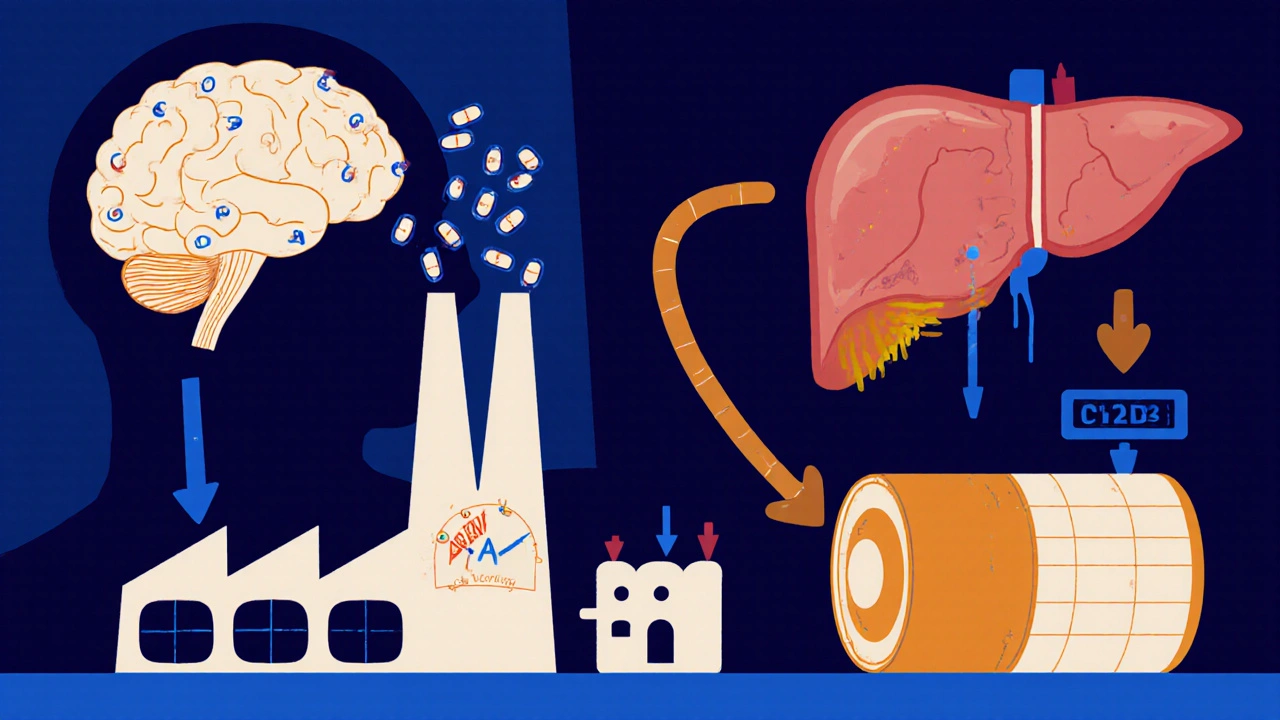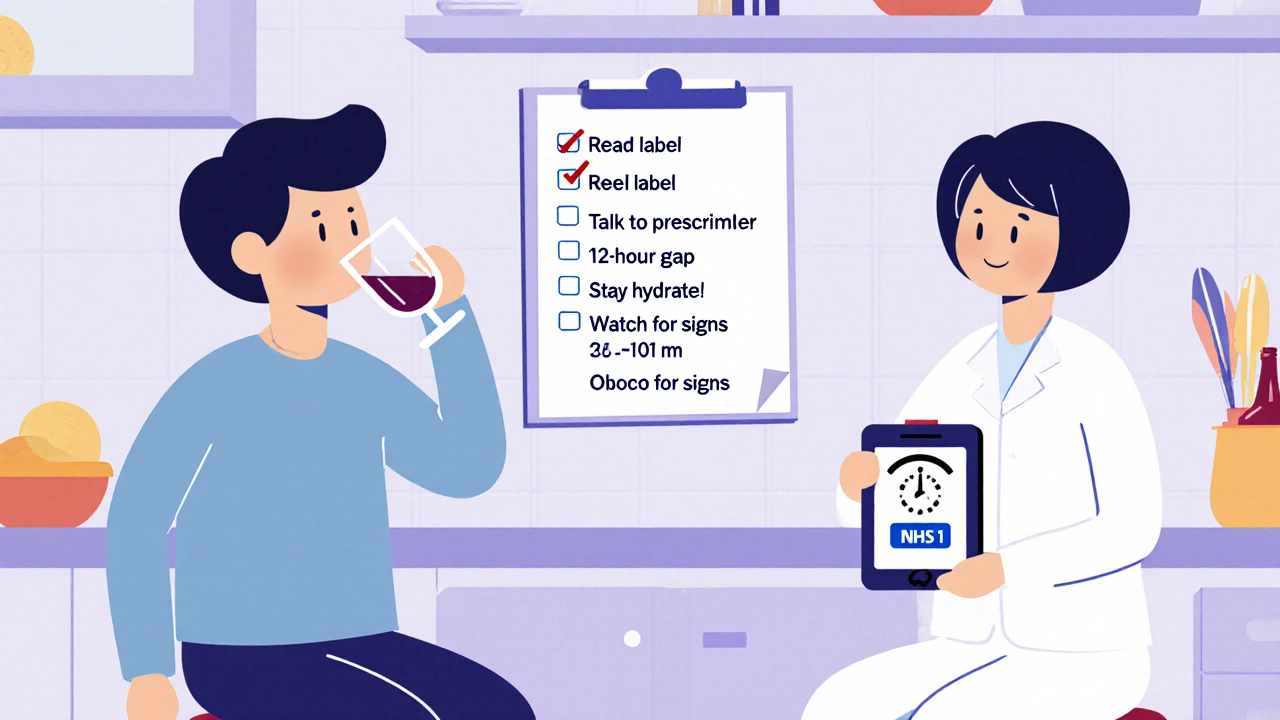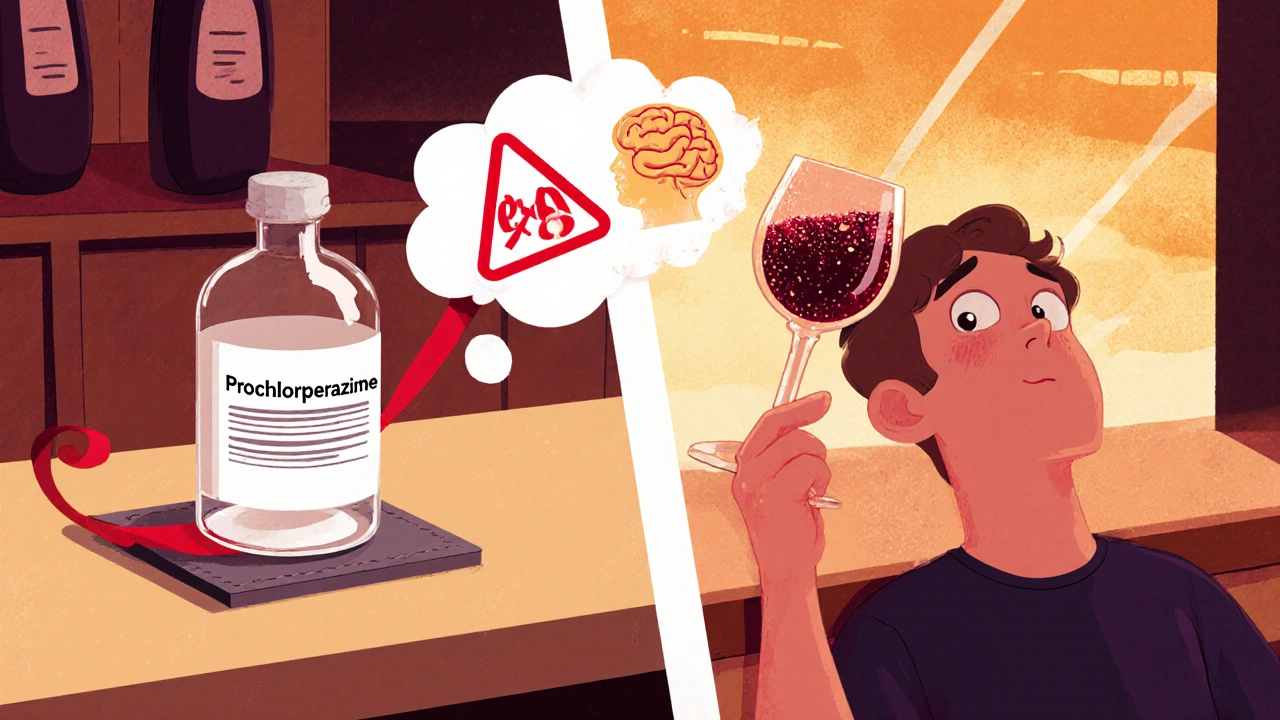Prochlorperazine Alcohol Timing Calculator
This tool helps you determine safe timing between taking Prochlorperazine and consuming alcohol. Based on the drug's 6-8 hour half-life, it calculates when the medication is sufficiently cleared from your system to minimize dangerous interactions.
Safety Recommendation
Mixing medication with booze can feel like a gamble, especially when the drug in question is prochlorperazine alcohol interaction. If you’ve ever wondered whether a night out is safe while taking an anti‑nausea pill, this guide breaks down the science, the signs to watch for, and the steps you can take to stay out of trouble.
What is Prochlorperazine?
Prochlorperazine is a dopamine receptor antagonist commonly prescribed for nausea, vomiting, vertigo, and sometimes psychosis. It belongs to the phenothiazine class, the same family that includes older antipsychotics like chlorpromazine. The drug works by blocking dopamine D2 receptors in the brain, which helps calm the “vomiting centre” in the medulla.
How Alcohol Affects Your Body
Alcohol is a central nervous system (CNS) depressant that slows brain activity, impairs coordination, and reduces the body’s ability to metabolise other substances. When you drink, the liver processes ethanol mainly via the enzyme alcohol dehydrogenase, but other pathways like CYP2E1 also get involved, creating metabolites that can further tax the liver.
Why Mixing Them Is Risky
Both Prochlorperazine and Alcohol hit the brain’s dopamine system, but from opposite angles. Prochlorperazine blocks dopamine receptors, while alcohol indirectly raises dopamine levels by affecting reward pathways. The clash can lead to unpredictable effects such as intensified sedation, dizziness, or even paradoxical agitation.
Beyond dopamine, the two substances share a metabolic pathway: the cytochrome P450 enzyme CYP2D6. Prochlorperazine is partially metabolised by CYP2D6, and heavy alcohol use can inhibit this enzyme, causing the medication to linger longer in the bloodstream. The result? Higher plasma concentrations and a greater chance of side‑effects like QT prolongation (a heart rhythm issue) and anticholinergic effects (dry mouth, blurred vision, constipation).

Common Side Effects When Combined
- Increased sedation - You may feel drowsy far quicker than with either substance alone.
- Profound CNS depression - This can manifest as slowed breathing, slurred speech, or trouble staying awake.
- Exacerbated nausea and vomiting - Ironically, the drug meant to stop these symptoms can trigger them when alcohol irritates the stomach lining.
- Orthostatic hypotension - A sudden drop in blood pressure when standing, leading to dizziness or fainting.
- Heart rhythm disturbances - Notably QT prolongation, which can precipitate dangerous arrhythmias.
- Worsened anticholinergic effects - Dry mouth, blurred vision, urinary retention.
Managing the Interaction
- Read the label: The patient information leaflet will flag alcohol as a contraindication or caution.
- Talk to your prescriber: Let your doctor know how often you drink. They may adjust the dose or suggest an alternative anti‑nausea drug such as ondansetron, which has fewer CNS effects.
- Time it right: If you must drink, keep a minimum 12‑hour gap after the last dose of Prochlorperazine. The drug’s half‑life is roughly 6‑8 hours, so waiting allows most of it to clear.
- Stay hydrated: Alcohol dehydrates, and dehydration can heighten dizziness and low blood pressure.
- Watch for warning signs: Sudden confusion, severe drowsiness, rapid heartbeat, or chest pain demand immediate medical attention.

When to Seek Help
If you notice any of the following, call emergency services or go to the nearest A&E:
- Unresponsiveness or inability to stay awake.
- Irregular heartbeats, especially palpitations or a racing pulse.
- Severe vomiting that won’t stop, leading to dehydration.
- Difficulty breathing or shortness of breath.
Even if symptoms seem mild, a phone call to your GP or a pharmacist can prevent complications later on.
Quick Checklist
- Know the dose: Typical Prochlorperazine doses range from 5 mg to 10 mg three times daily for nausea.
- Alcohol limit: Stick to a single standard drink (≈14 g of pure alcohol) if you’ve missed a dose and the drug is out of your system.
- Monitor: Use a simple log - date, dose, alcohol amount, any side‑effects - to share with your healthcare provider.
- Emergency contacts: Save the local NHS 111 number and the nearest hospital’s A&E in your phone.
| Effect | Prochlorperazine Only | Prochlorperazine + Alcohol |
|---|---|---|
| Sedation | Mild‑to‑moderate | Marked increase, often severe |
| CNS Depression | Low risk | High risk, possible respiratory slowdown |
| QT Prolongation | Rare | More likely, especially with high‑dose alcohol |
| Orthostatic hypotension | Occasional | Frequent, can cause falls |
| Gastro‑intestinal upset | Occasional nausea | Can exacerbate vomiting |
Can I have a glass of wine while taking Prochlorperazine?
One small glass may not cause severe problems for most people, but it increases sedation and the chance of dizziness. The safest route is to avoid alcohol entirely until the drug has cleared your system (about 12‑24 hours after the last dose).
Does Prochlorperazine affect blood alcohol level readings?
Prochlorperazine does not directly alter the ethanol concentration measured by breathalyzers, but its sedative effects can make you look more intoxicated than the blood alcohol level suggests.
What should I do if I feel extremely drowsy after drinking?
Sit or lie down in a safe place, sip water, and avoid driving. If drowsiness turns into difficulty staying awake, call NHS 111 or go to A&E-you may be experiencing dangerous CNS depression.
Are there alternatives to Prochlorperazine that are safer with alcohol?
Medications like ondansetron or metoclopramide have less sedation and fewer heart‑related side‑effects, making them a better choice if you expect occasional alcohol consumption. Always discuss alternatives with your doctor.
How long does Prochlorperazine stay in the body?
The drug’s half‑life is about 6‑8 hours, so it takes roughly 24‑36 hours to be eliminated after the last dose. Factors like liver function and age can extend this period.


Comments (5)
Thokchom Imosana
October 19, 2025 AT 15:26Ever wonder why the pharmaceutical giants keep their worst side‑effects hidden behind fine print while pushing drugs like prochlorperazine into the market? It's not a coincidence; it's part of a larger schema orchestrated by shadowy entities that profit from our dependence on synthetic chemistry. The fact that alcohol interacts with this dopamine antagonist is deliberately downplayed because it exposes how delicately balanced our neurochemical pathways are under corporate control. When you consume ethanol, the liver's CYP450 enzymes become saturated, allowing the drug to linger, which in turn amplifies sedation and can trigger cardiac arrhythmias that the label barely mentions. This is a classic example of the “dual‑use” strategy: market a medication for benign nausea while retaining the ability to weaponize its side‑effects in a controlled environment. The hidden link to QT prolongation isn’t just a medical curiosity; it’s a gateway for surveillance technologies that monitor heart rhythms for undocumented purposes. Moreover, the dopamine blockade interferes with reward circuits, subtly muting our motivation to question authority, which is exactly what the architects of the pharmaco‑industrial complex want. You might think a single glass of wine is harmless, but that myth is perpetuated by lobbyists who fund the very studies you read. The metabolic bottleneck at CYP2D6 is another lever; by inhibiting it with alcohol, you create a feedback loop that heightens the drug’s psychoactive profile, making users more susceptible to suggestion. It’s no accident that the warning signs are vague: “consult your physician” is a euphemism for “don’t trust the source of this information.” If you truly care about your health, you must look beyond the pamphlet and understand the geopolitical forces that dictate which interactions are disclosed and which are buried. The risk isn’t merely physiological-it’s epistemological, eroding the ability to make informed choices in a world where truth is commodified. So, before you pour that cheap wine, ask yourself: who benefits from your impaired judgment?
Stay vigilant, stay skeptical, and remember that every pill comes with a hidden agenda.
ashanti barrett
October 28, 2025 AT 08:53I totally get how unsettling it can feel reading about these interactions, especially if you rely on prochlorperazine for nausea. The key takeaway is that you don’t have to live in fear-just be proactive. Keep a solid log of dosing times and any alcohol you consume; even a single drink can tip the balance toward excessive drowsiness. Hydration is your best friend, and if you ever notice sudden dizziness or a racing heart, treat it as a red flag and seek help immediately. Talk to your prescriber about alternatives like ondansetron if you anticipate occasional drinking-it’s less likely to cause the severe QT prolongation we worry about. Remember, the half‑life is about 6‑8 hours, so spacing drinks at least 12 hours after your dose gives your system a chance to clear most of the drug. You’ve got this, just stay aware and listen to your body.
Leo Chan
November 6, 2025 AT 02:20Hey folks, just wanted to add a quick boost of optimism here! If you’re on prochlorperazine and thinking about having a drink, you can totally manage it safely by planning ahead. Set a reminder to wait at least half a day after your last pill before you enjoy that glass of wine, and keep a water bottle handy to stay hydrated. Small steps like tracking your dose and alcohol intake in a simple notebook can make a huge difference and keep you feeling in control. You’ve already taken the first smart step by reading this guide-keep that momentum going and stay safe!
jagdish soni
November 14, 2025 AT 19:47Well said Leo but let me add a nuance the casual crowd tends to miss
the interplay between dopamine antagonism and alcohol‑induced reward circuitry is not merely additive it's synergistic in a way that can produce an illusory sense of calm while actually destabilizing autonomic regulation
think of it as a quiet storm brewing behind the scenes and the best way to dodge it is to respect the pharmacokinetic timeline rather than gamble on a vague “one drink” rule
Latasha Becker
November 23, 2025 AT 13:15From a pharmacodynamic perspective, the assertion that a single standard drink is innocuous fails to account for interindividual variability in CYP2D6 enzymatic activity, which can be phenotypically categorized as poor, intermediate, extensive, or ultra‑rapid metabolizers. Consequently, the resultant plasma concentration of prochlorperazine may exceed the therapeutic window, precipitating dose‑dependent QT interval elongation. Moreover, the concomitant anticholinergic burden exacerbates orthostatic hypotension, a phenomenon quantitatively expressed via the baroreceptor reflex attenuation coefficient. Therefore, a blanket recommendation lacks the granularity required for evidence‑based clinical guidance.